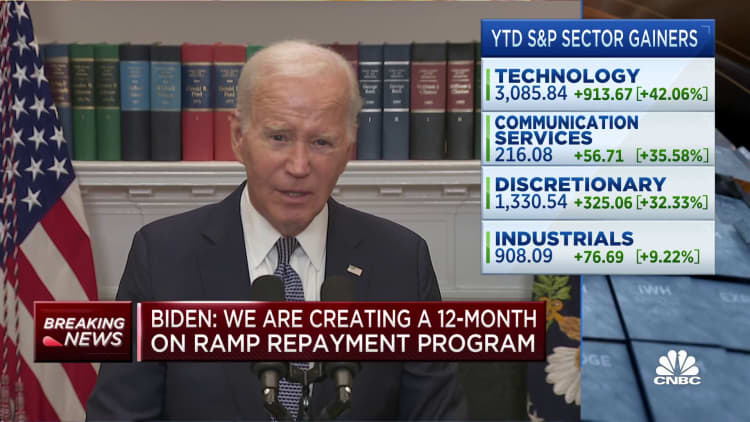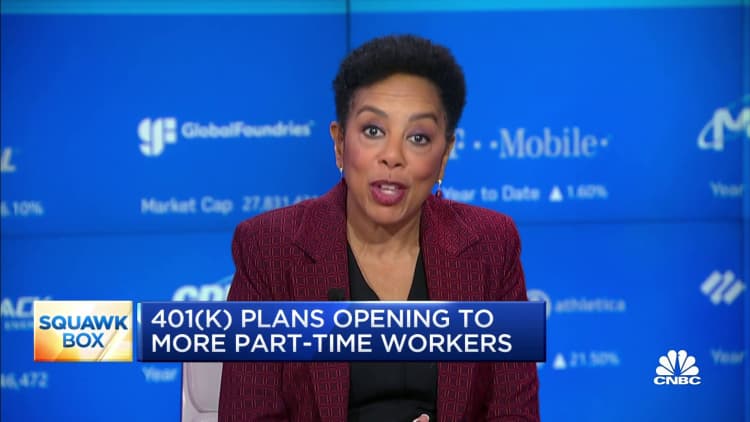Personal Finance
How to make your home hurricane resistant amid climate change
Published
2 weeks agoon

Ryersonclark | E+ | Getty Images
Making your home hurricane resistant can be a significant financial undertaking. But it’s one that has the potential to pay off as such storms become more intense amid climate change.
In 2024, the national average cost to upgrade an entire house with hurricane windows runs between $1,128 and $10,293, or $100 and $500 per window, including installation, according to This Old House. And that’s just one project.
Upgrades could help consumers protect their home, typically one of their most valuable assets, from windstorms and other natural disasters.
About $8.1 billion could be saved annually in physical damages from windstorms if homes had stronger connections between roofs and walls, or tighter nail spacing, according to a 2022 analysis on hurricane-resistant construction by the Massachusetts Institute of Technology.
‘Now’s the time to prepare’
Hurricanes are among the most expensive natural disasters in the U.S., and experts say the storm-related damage is likely to become more significant as storms become more severe.
Some of the projected effects of global warming on hurricane activity include sea level rise increasing coastal flooding, higher rainfall rates and storms that are more intense and strengthen rapidly, according to a research overview from the National Oceanic and Atmospheric Administration’s Geophysical Fluid Dynamics Laboratory.
“Warmer sea surface temperatures intensify tropical storm wind speeds, giving them the potential to deliver more damage if they make landfall,” notes the Center for Climate and Energy Solutions, a think tank.
Projections from reinsurer Swiss Re show that since the 1970s, hurricane residential-loss expectations have been on the rise, in part due to an increase in hurricane activity and changes in property value from population growth. Improvements in building standards have offset some of that increase, however.
More from Personal Finance:
Renters are most exposed to climate hazards in these two states
Over 18 million rental units at risk of environmental hazards
Why buyers of newly built homes can face a property tax surprise
Scientists anticipate an “extremely active” hurricane season in 2024 due to record-warm tropical and eastern subtropical Atlantic sea surface temperatures, according to hurricane researchers at Colorado State University.
The latest forecast calls for 23 named storms, 11 of which are slated to spiral into hurricanes. Of those, five are expected to reach “major” levels, or category 3, 4 or 5 storms with sustained winds of at least 111 miles per hour.
This year, the water temperature across the tropical Atlantic on average are about 1 degree Celsius, or 1.5 to 2 degrees Fahrenheit warmer than normal. While it doesn’t sound like much, it’s a big difference, said Phil Klotzbach, a senior research scientist at the Department of Atmospheric Science of Colorado State University.
“The tropical Atlantic right now is record warm,” he said. “That means more fuel for the storms that are trying to form.”
While atmospheric and water conditions may change, it’s wise for residents of storm-prone areas to think about undertaking home projects sooner rather than later.
“Now’s the time to prepare and have a plan in place,” said Klotzbach. “You don’t want to be making these preparations at the last minute.”
Hurricane resistance is about preventing ‘pressurization’
Hurricanes are different and unpredictable storms, said Jeff Ostrowski, a housing analyst at Bankrate.
“You don’t know if you’re going to be dealing with storm surge, or high winds or heavy rains. You’re trying to prepare for all those things at once,” he said.
It’s like a balloon that blows up, and when it blows up so much … it pops.
Leslie Chapman-Henderson
president and chief executive officer of the nonprofit Federal Alliance for Safe Homes
There are two key elements in your home to help prevent wind-related damage in a hurricane, according to Leslie Chapman-Henderson, president and chief executive officer of the nonprofit Federal Alliance for Safe Homes, or FLASH. You want to:
- Make sure the structural strength between the roof and the wall can withstand wind pressure and impact of debris.
- Protect all the openings in your home: the doors, windows and the garage.
“What we’re working to prevent is pressurization. It’s like a balloon that blows up, and when it blows up so much … it pops,” she said. “That’s what happens to your house when the wind comes in.”
Ways to make your home more hurricane resistant
1. Have an inspector assess your house
Having an inspector come out to see your house is a good starting point for your projects. They will provide a report of what areas in your home need to be redone or reinforced against harsh weather.
2. Reinforce your roof
The average cost to replace a roof in the U.S. is about $10,000, but the exact cost will depend on multiple factors, like the size of your roof, according to the Department of Energy.
For someone getting ready to re-roof their house, Fortified, a nonprofit organization re-roofing program that helps strengthen homes against severe weather, will offer guidelines on how to make the roof sturdy to withstand challenges in your area, said Jennifer Languell, president and founder of Trifecta Construction Solutions, a sustainable consulting firm in Florida.
“It tells you want you need to do to make your roof more sturdy,” she said.
If you’re not ready to completely re-roof your house, adding caulk or an adhesive to strengthen the soffits of your house (that is, the material connecting the roof edge to the exterior walls) will reduce the probability of wind and water gushing into your attic in a storm, said Chapman-Henderson of FLASH. Repair jobs for the soffit and fascia, a horizontal board usually outside the soffit, can cost between $600 to $6,000, according to Angi.com.
The roof-to-wall connection is another thing to secure in an existing home with an attic. Installing metal clips and straps strengthens the hold-down effect, essentially anchoring your house, she said. While the exact cost will depend on factors like the size of your home and the scale of the project, such retrofitting costs span from $850 to $1,350, according to Kin, a home insurance company.
You can do all this stuff in terms of hardening the house, but you’re still kind of at the mercy of whatever storm comes.
Jeff Ostrowski
housing analyst at Bankrate
3. Secure your windows and doors
“Do you have hurricane-impact windows? If not, can you put them in?” said Melissa Cohn, regional vice president of William Raveis Mortgage.
If installing new hurricane windows aren’t in the budget, shutters are lower-cost options to protect windows and other openings, said Chapman-Henderson.
Different types of shutters vary by material, installation and price. Removable galvanized storm panels made of steel are $5 to $6 per square foot, making them the most affordable option, according to information compiled by FLASH.
It may be worth installing shutters as an extra layer of protection, even with impact-proof windows, said Trifecta Construction Solutions’ Languell.
Meanwhile, garage doors are the “largest and weakest opening,” said Chapman-Henderson. Replacing the entire garage door for a wind-rated or impact-resistant version can span from $2,000 to $9,000, according to FLASH.
Emergency bracings can be a lower-cost solution: temporary 2-by-4 wood braces can reinforce your nonwind-resistant door for approximately $150 for materials and installation. A garage door storm kit can run up to $750, FLASH data found.
“You can do all this stuff in terms of hardening the house, but you’re still kind of at the mercy of whatever storm comes,” said Bankrate’s Ostrowski.
4. Talk to your insurer about possible discounts
Strengthening your home against disasters may help lower your insurance cost.
Insurers typically factor in natural-disaster risks when deciding what properties to underwrite and at what cost. That’s why some are pulling back in high-risk areas, or raising prices significantly.
Insurance costs also tend to be higher for existing homes than newly built ones, because such properties were constructed under less stringent building codes.

Once you have an inspector visit your house and recommend projects to make your home more hurricane resistant, talk to your insurance agent about which of the suggestions are most likely to reduce your premium, Ostrowski said.
Keep in mind that each state is different in terms of what premium reductions are available and to what extent, and it depends on the risks, the company’s exposure and the regulatory environment, said Loretta Worters, a spokeswoman for the Insurance Information Institute.
Homeowners’ insurance premium rates are based on measurable risk and while mitigation efforts might help reduce the risk, the scientific measurement of catastrophe risk and mitigation efforts is still evolving, she said.
“All analysis of premium pricing related to mitigation efforts is a question of degree of risk, and not removal of risk entirely from the policy,” Worters said.
Grants, financing can help mitigate costs
If the cost to prepare your home against hurricanes is daunting, there may be grants, tax credits and other programs to help lessen the burden.
Some states have set up matching grant programs for disaster retrofits, said Chapman-Henderson.
In Florida, residents may be eligible to apply for matching grants that go up to $10,000 dollar-for-dollar match for approved upgrades like shutters, roofing and strengthening your garage door roof-to-wall connections, she said. There are similar programs in Alabama and Louisiana.
To find out more, homeowners can search for loans, grants or tax credits available in their state through dsireusa.org, which lists all of the funding opportunities and incentives to harden your home against disasters, Languell said.
For people with poor credit or who live in states that don’t have matching-dollar programs, Property Assessed Clean Energy programs allow a homeowner to finance upfront costs of eligible improvements on a property and pay the costs over time through the property tax bill, said Chapman-Henderson.
Energy-efficient mortgages, also referred to as green mortgages, may also be worth exploring. These loans are meant to help homeowners finance eco-friendly home upgrades or outright buy homes that help reduce energy consumption and lower utility bills, although they often have strict loan limits and require additional information during your application, according to LendingTree.
Depending on your hurricane-resistance project, that might be a fit: Sometimes, energy efficiency goes hand-in-hand with durability, Languell said.
“Sealing the underside of your roof sheathing would also help you from an energy standpoint because it’s sealing all the cracks and crevices,” she said, as this repair both keeps your roof on your house and helps avoid water or air leaks.
The same goes with window replacements: “If you are going to replace your windows from a single-pane window to an impact window that has a better energy performance, it’s saving you on energy,” Languell said.
In this new series, CNBC will examine what climate change means for your money, from retirement savings to insurance costs to career outlook.
Has climate change left you with bigger or new bills? Tell us about your experience by emailing [email protected].
Don’t miss these exclusives from CNBC PRO
You may like
Personal Finance
Here are key things to know about company stock, experts say
Published
2 weeks agoon
May 4, 2024
Prasit photo | Moment | Getty Images
As employers compete to attract and retain talent, equity compensation — or an ownership stake in the company — has become a key workplace benefit.
Some 72% of companies offer some form of equity compensation to certain employees, a 2023 survey from Morgan Stanley found. That’s up from 65% in 2021.
These perks motivate employees and boost their long-term investing goals, according to the Morgan Stanley survey, which polled 1,000 U.S. employees and 600 human resource executives.
However, some “miss the opportunity” because they don’t understand it, said certified financial planner Chelsea Ransom-Cooper, chief financial planning officer for Zenith Wealth Partners in New York.
More from Personal Finance:
This job perk is like a ‘cash bonus’ — but you need a long-term strategy, experts say
Employee stock purchase plans offer ‘free money’ — but also carry complexity and risk
Treasury Department announces new Series I bond rate of 4.28% for the next six months
Here’s what to know about three popular types of stock-based compensation, experts say.
There’s potential for ‘life-changing wealth’
Many employees receive so-called stock options as part of their compensation, which are the right to buy or “exercise” company shares at a preset price within a specific timeframe.
“It’s almost iconic to grant stock options in a startup private company,” said Bruce Brumberg, editor-in-chief and co-founder of myStockOptions.com, which covers various types of equity compensation.
Startups want to create the drive and incentive of ownership culture with the potential for “life-changing wealth,” he said.
Stock options become valuable when there’s a discount between your preset price and the market value, which makes it more attractive to exercise. However, the taxes can be complicated, depending on the type of stock options.
Incentive stock options can offer some tax benefits — if you meet certain rules — but could trigger the alternative minimum tax, a parallel system for higher earners.
Photo by LanaStock via Getty Images
By comparison, the more common nonqualified stock options generally have less favorable tax treatment and you’ll owe regular income taxes on the discount upon exercise.
But even with an initial discount, there’s no guarantee a company’s stock price won’t decrease after exercising a stock option.
“It could be worth nothing but a piece of paper,” Ransom-Cooper from Zenith Wealth Partners said.
Restricted stock units are ‘like a cash bonus’
Another benefit, restricted stock units, or RSUs, are company shares granted upon hiring, which vest over time. RSUs can also be tied to performance-based goals.
Some 94% of public companies offer RSUs to at least middle managers, according to a 2021 survey from the National Association of Stock Plan Professionals.
“I like to think of it like a cash bonus,” said Pittsburgh-based CFP Matthew Garasic, founder of Unrivaled Wealth Management.
I like to think of it like a cash bonus.
Matthew Garasic
Founder of Unrivaled Wealth Management
For example, if the stock price is $10 and 100 shares vest, it’s treated like $1,000 in compensation for that year, and the standard withholding of 22% might not be enough, depending on your tax bracket, he explained.
After vesting, the decision to sell or hold RSUs depends on your short- and long-term investing goals.
“We like to establish a target of what they like to hold in company stock,” said Garasic, who aims to keep allocations of a single stock to 10% or less. “Once we get above that target, we just sell at vest.”
Employee stock purchase plans offer ‘free money’
Many publicly traded companies may also offer discounted company shares via an employee stock purchase plan, or ESPP.
“There’s free money to be had” with an ESPP, Garasic explained.
However, the decision to participate typically depends on your short-term financial goals.
After enrolling, your ESPP collects a portion of after-tax money from each paycheck and uses the funds to buy discounted company stock on a specific date.
The gold standard is a 15% discount with a lookback feature, which bases the stock purchase price on the value at the beginning or end of the offering period, whichever is lower, experts say.
Any time you’re investing in a single company, there’s certainly a big risk.
Kristin McKenna
President of Darrow Wealth Management
You can typically sell after a set period, but there’s no guarantee you’ll make money, even with the built-in discount.
“Any time you’re investing in a single company, there’s certainly a big risk,” CFP Kristin McKenna, president of Darrow Wealth Management in Boston, previously told CNBC.
Yearly goals like investing up to your employer’s 401(k) match should come before your ESPP, especially with limited income, she added.

Personal Finance
Public Service Loan Forgiveness program will go on partial pause
Published
2 weeks agoon
May 3, 2024
Teacher teaching her students in art class at school.
Fg Trade | E+ | Getty Images
The popular Public Service Loan Forgiveness program began a partial processing pause on May 1, which will likely run through July, the U.S. Department of Education recently said.
The temporary suspension comes as the Biden administration overhauls the once-troubled federal student loan program.
Here’s what borrowers should know.
Why the pause is happening
The PSLF program, signed into law by President George W. Bush in 2007, allows certain not-for-profit and government employees to have their federal student loans canceled after 10 years of on-time payments.
However, the program has been plagued by problems, making people who actually get the relief a rarity.
Borrowers often believe they’re paying their way to loan cancellation only to discover at some point in the process that they don’t qualify, usually for confusing technical reasons. Lenders have been blamed for misleading borrowers and botching their timelines.
More from Personal Finance:
Advice about 401(k) rollovers is poised for a big change. Here’s why
IRS free filing pilot processed more than 140,000 returns, commissioner says
Here’s why new home sales inch higher despite 7% mortgage rates
The Biden administration has been trying to reform the program. As part of that overhaul, it is changing how loan servicing works for public servants, and some of the customer service will soon be handled by the government itself.
“After the improvements, PSLF borrowers will have all of their PSLF information centralized on StudentAid.gov so that the Department can provide real-time and more accurate information on payment counts and form processing,” the Education Department wrote in a recent blog post.
Previously, only one company managed the servicing for PSLF borrowers on behalf of the government: first, FedLoan, and more recently, Mohela, or the Missouri Higher Education Loan Authority. Going forward, a number of different companies will service the accounts, along with the Education Department.
What borrowers can expect during the transition
The Education Department will not review PSLF form submissions for roughly a two-month period, it says. (The exact dates will depend on how long the changes take place to complete.)
Meanwhile, from May 1 through July, it says, “borrowers will not be able to see their PSLF payment counts on MOHELA’s website.”
“During the transition, PSLF forgiveness will be suspended,” said higher education expert Mark Kantrowitz.

Borrowers will be able to continue making their loan payments, and these months will count on their timeline to loan forgiveness. Borrowers should also be able to submit a form to certify public service employment and to apply for loan forgiveness if they are at the 10-year mark.
“Forms will be reviewed as soon as the transition is complete,” the Education Department says.
If you qualify for debt cancellation during the transition, you can request a forbearance from your servicer in the meantime, it says, adding that any overpayments should be refunded.
Don’t miss these exclusives from CNBC PRO
Personal Finance
Your Roth 401(k) after-tax matching contribution could trigger taxes
Published
2 weeks agoon
May 3, 2024
If you’ve opted into your employer’s Roth 401(k) after-tax matching contributions this year, it could trigger a tax surprise without proper planning, experts say.
Enacted in 2022, Secure 2.0 ushered in sweeping changes for retirement savers, including the option for employers to offer 401(k) matches in Roth accounts. These accounts are after-tax, meaning employees pay upfront taxes but growth and withdrawals in retirement are tax-free. Previously Roth 401(k) matches went into pretax accounts.
Roughly 12% of employers with 401(k) plans said they are “definitely” adding the feature and 37% are “still considering it,” according to a recent survey from the Plan Sponsor Council of America.
However, those new matching Roth contributions could have “unintended consequences” at tax time, according to Tommy Lucas, a certified financial planner and enrolled agent at Moisand Fitzgerald Tamayo in Orlando, Florida.
More from Personal Finance:
IRS aims to more than double its audit rate on wealthiest taxpayers
Here are three ways to lower your credit card annual percentage rate, experts say
Why your financial advisor may not give you the best Social Security advice
“If you go this route, you’ll want to know that you’re basically getting extra income” and taxes aren’t automatically withheld, Lucas said.
“You’re increasing your adjusted gross income by taking this match as a Roth,” he said.
“If you go this route, you’ll want to know that you’re basically getting extra income.”
Tommy Lucas
Financial advisor at Moisand Fitzgerald Tamayo
For example, let’s say your salary is $100,000 with a 6% employer match in 2024. If you designate your $6,000 employer match as Roth and you’re in the 22% federal income tax bracket, you could have an extra $1,320 in tax liability, according to Lucas.
“There’s probably something on top of that for state income taxes,” depending on where you live, he said.
Plus, you won’t see your employer’s matching Roth contribution reported on Form W-2, according to IRS guidance released late last year. Instead, you’ll receive Form 1099-R, which could be confusing, Lucas said.
How to plan for income from Roth 401(k) matches
If you’ve chosen your company’s Roth matches for 2024, you need to prepare for the extra income, said CFP Jim Guarino, managing director at Baker Newman Noyes in Woburn, Massachusetts. He is also a certified public accountant.
You can increase your federal and state withholdings with your employer or boost your quarterly estimated tax payments, he said.

For example, if you expect to incur $1,320 more in federal taxes, you could divide that amount by your remaining 2024 paychecks and include that “extra withholding” on Form W-4 for your employer, Lucas said.
Of course, you’ll need to double-check that the change is reflected on future paychecks, he said.
“In either case, working with a trusted tax advisor would help to optimize overall tax planning and eventual tax reporting for the year,” Guarino added.
Don’t miss these exclusives from CNBC PRO

Betting on the Kentucky Derby? Here’s how to think like a professional handicapper.

Warren Buffett says Greg Abel will make Berkshire Hathaway investing decisions when he’s gone

EV makers win 2-year extension to qualify for tax credits

Are American progressives making themselves sad?

‘Best Firms for Tech’ 2024 deadline extended to April 10

